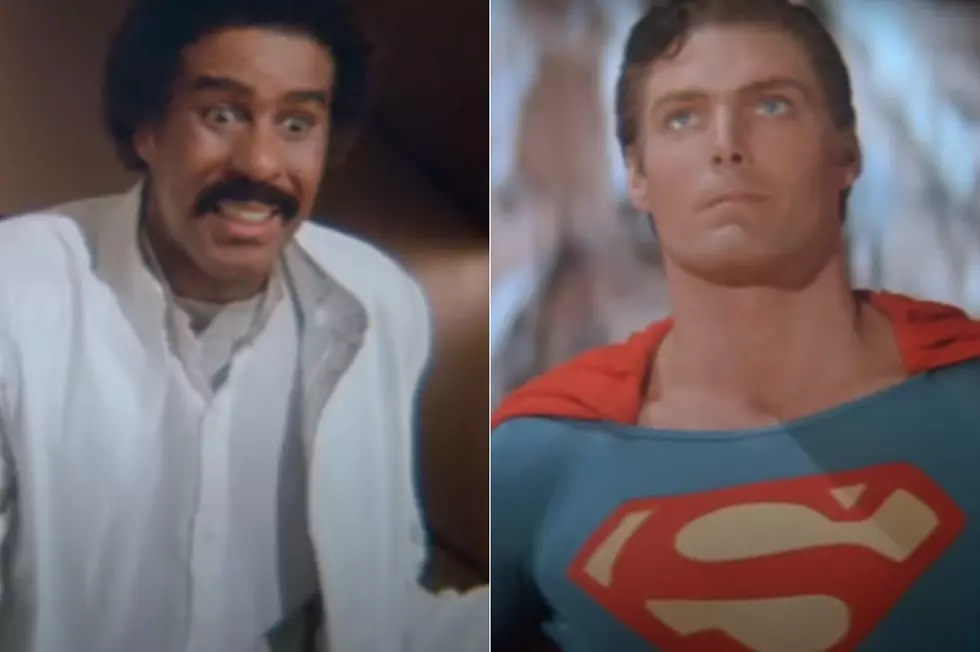
40 Years Ago: How ‘Superman III’ Torpedoed the Franchise
The story of the original Superman franchise is one of tragically missed opportunities. It's a mournful tale rooted in all of the things that can doom a movie: writers with shoddy ideas, egomaniacal producers and inept directors. The saga reached its nadir with the release of Superman III on June 17, 1983, which effectively torpedoed the franchise.
The series began promisingly enough in the '70s, when the father/son production team of Alexander and Ilya Salkind hired novelist and The Godfather author Mario Puzo to write a single screenplay that would encompass both a Superman film and a sequel. Puzo's original script, as Ilya Salkind recalled in a 2005 interview, exceeded 500 pages and was extremely campy, including a now-notorious scene in which Superman mistakes Kojak star Telly Savalas for Lex Luthor.
Puzo's script was rejected, but its comedic aspects remained in rewrites done by David and Leslie Newman, and then Robert Benton. Still dissatisfied with its tone, director Richard Donner hired Tom Mankiewicz to write a more serious version of the first Superman film, which was released in 1978 to much acclaim.
The success didn't equate to good working conditions, though. The Salkinds were notoriously difficult to work with and drove Donner off the sequel during production. As Jack O'Halloran, who played the unspeaking villain Non in Superman II, remembered in a 2001 interview: "The Salkinds were assholes and caused all the commotion that there was on the film."
Watch the Trailer for 'Superman III'
The Salkinds replaced Donner with Richard Lester, a director with an offbeat aesthetic whose career had never quite lived up to the early acclaim he'd received for directing the Beatles' films A Hard Day's Night and Help! Although Donner had already filmed a good deal of Superman II by the time he was fired, Lester implemented several changes when he took over. He wanted to revert to the campy tone of Puzo's original script and demanded another rewrite by the Newmans to get it there.
Lester's approach, along with the Salkinds' treatment of Donner, so infuriated Lex Luthor actor Gene Hackman that he refused to participate in the new scenes being filmed, which greatly reduced his role in the final version of the movie. Margot Kidder, who played Lois Lane, felt similarly, which resulted in her being almost entirely cut out of the third film.
Superman II did well at the box office, although it was not the massive hit the first film had been, and when the time came to make a third film, the franchise was entirely in the hands of the Salkinds and Lester. The result was a movie that dispensed with most of the Superman mythos in favor of campy, broad comedy, leaving millions of disappointed fans in its wake.
The film opens with a silly pratfall sequence involving mechanical toy penguins, then shifts to the story of Gus Gorman (Richard Pryor, who was cast after appearing on The David Letterman Show and talking about how much he wanted to be in a Superman movie), an unemployed sad-sack who realizes he has a genius for computer programming. Gorman is eventually hired by Bubba Webster (Robert Vaughn), a wealthy industrialist who wants to harness his programming skills for nefarious deeds, such as taking over the world's coffee and oil supplies and developing a super-powerful artificial intelligence.
Watch Richard Pryor Ski Off a Building in 'Superman III'
Meanwhile, Clark Kent/Superman (played with typical verve by Christopher Reeve) has gone home to Smallville and struck up a relationship with his high school crush Lana Lang (Annette O'Toole). Eventually, the two plot lines collide, and Superman defeats Webster and his AI with a little help from Gorman, who is suddenly repentant about his role in the debacle.
The movie is a mess from top to bottom. Despite his great acting chops, Vaughn is a spectacularly lukewarm villain. Pryor has some funny scenes, but the movie spends so much time on his character that it threatens to become about him instead of Superman. And despite one strong sequence in which Superman is split into an evil side and a good side and the two halves battle in a junkyard, the action sequences are remarkably limp.
Watch Superman Battle Clark Kent in 'Superman III'
But the film's biggest and most consistent problem is its tone, which is driven by a terrible script and Lester's ill-fitting aesthetic. There's a sequence in which Pryor skis off the top of a skyscraper and survives, and one in which he impersonates an Army general. Superman III is filled with so many sight gags and flaccid attempts at humor that it often resembles a bad '70s comedy instead of a superhero movie.
It's the kind of film that can put a stake through the heart of a franchise — and it nearly did. Despite its savage reviews, Superman III had enough juice to spawn two more series installments — 1984's Supergirl and 1987's Superman IV: The Quest for Peace — but both were box office bombs, and the character would not return to the big screen until 2006's Superman Returns.
In hindsight, the remarkable thing isn't that Superman III was so bad, but that the original Superman was so good, given the many problems with producers and writers that plagued the franchise from the beginning. But such is life in Hollywood.




